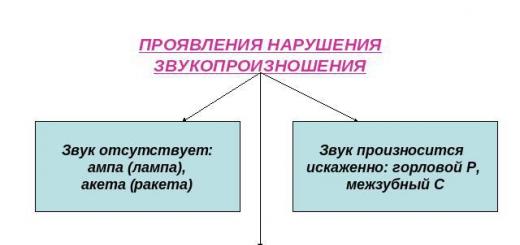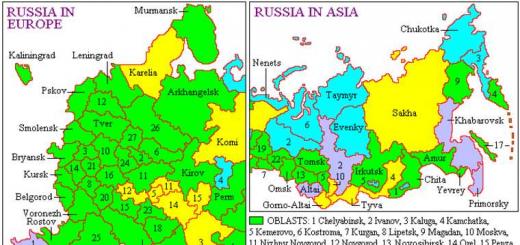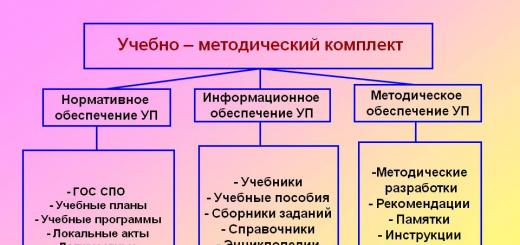Concretization is the replacement of a SL word or phrase with a broader meaning with a TL word or phrase with a narrower meaning. As a rule, the vocabulary of the Russian language is characterized by greater specificity than the corresponding lexical units of the English language. This has been noted many times by linguists. Specification can be linguistic and contextual (speech). During linguistic specification, the replacement of a word with a broad meaning with a word with a narrower meaning is determined by differences in the structure of the two languages - either by the absence in the TL of a lexical unit that has the same broad meaning as the transmitted FL unit, or by differences in their stylistic characteristics, or by the requirements of grammatical order (the need for syntactic transformation of the sentence, in particular, replacing the nominal predicate with a verb, examples of which will be given below).
Verbs of motion and verbs of speech are specified when translated into Russian: be, have, get, take, give, make, say, come, go, etc.:
At the by-election victory went to the Labor candidate.
Labor won the by-election (the Labor Party candidate won).
The rain came in torrents.
It began to rain heavily.
‘So what?’ I said. (J. Salinger, The Catcher in the Rye).
So what? I ask.
Didn't tell me to come right over, if I felt like it.
He told me to come now if necessary.
Here are examples of the transformation of a Russian nominal predicate into an English verb, which usually requires specification of the verb be, for example: Not is at school - He studies at school; Not is in the Army - He serves in the army; The concert was on Sunday - The concert took place on Sunday. (1)
As for contextual specification, it can be determined by factors of a given specific context, most often stylistic considerations, such as the need for completeness of a phrase, the desire to avoid repetition, achieve greater imagery, clarity, etc. For example:
You could hear him putting away his toilet articles.
You could hear him putting away his soap dishes and brushes.
Concretization is the replacement of a FL word or phrase with a broader subject-logical meaning with a TL word and phrase with a narrower meaning. As a result of applying this transformation, the created correspondence and the original lexical unit find themselves in a logical relationship of inclusion: the FL unit expresses a generic concept, and the TL unit expresses the specific concept included in it:
Dinny waited in a corridor which smelled of disinfectant. Dinny waited in the corridor, which smelled of carbolic acid. Wasn't at the ceremony. He attended the ceremony.
In some cases, the use of specification is due to the fact that there is no word with such a broad meaning in the TL. Thus, the English noun thing has a very abstract meaning (an entity of any kind) and is always translated into Russian by concretization: “thing, subject, matter, fact, case, being,” etc.
Sometimes the generic name in the target language cannot be used due to divergence in the connotative components of the meaning. The English meal is widely used in various styles of speech, and the Russian “food intake” is not used outside of special vocabulary. Therefore, as a rule, when translating meal is replaced by the more specific “breakfast, lunch, dinner”, etc.:
At seven o"clock an excellent meal was served in the dining-room.
At seven o'clock an excellent dinner was served in the dining room. It is clear that the choice of a more specific name is entirely determined by the context, and in other conditions dinner could have been served at seven o’clock (in the evening).
Specification is often used when there is a word in the TL with an equally broad meaning and corresponding connotation, since such words may have different degrees of usage in the FL and TL. Above (see p. 138) the high frequency of words with a broad meaning in English has already been noted. When translating such words, specification is a very common method of translation. In Charles Dickens's novel "David Copperfield," the behavior of the hero's mother, frightened by the sudden appearance of the formidable Miss Betsy, is described as follows:
My mother had left her chair in her agitation, and gone behind it in the corner.
The English verbs with the common meaning to leave and to go cannot be translated here by the corresponding Russian verbs "to leave" and "to go". The unacceptability of the translation “Mother left her chair and went to the corner behind him” is beyond doubt; the Russian language does not describe such a specific emotional situation in this way. The best way to ensure equivalence of the Russian translation is to specify the specified verbs:
The excited mother jumped up from her chair and hid in the corner behind him.
Another sentence from the same novel should be translated in a similar way:
My old dear bedroom was changed, and I was to lie a long way off.
Arriving home after a long absence, the boy sees that everything in the house has changed and has become alien to him. Using direct matches would make the translation of this English sentence unclear. Why should anyone "lay away from the bedroom"?
The context shows that "lying" here means "sleeping" and "away" means just another part of the house. This is exactly how it should be said in Russian: My dear old bedroom was no longer there, and I had to sleep at the other end of the house.
The specification of the English verbs of “speaking” to say and to tell is widespread, which can be translated into Russian not only as “speak” or “say”, but also more specific “say, repeat, notice, assert, report, ask, object, order”, etc.:
"So what?" I said.
So what? - I asked.
language translation linguistic verbal
Professionals often encounter common problems. One of them is the more specific vocabulary of the Russian language compared to its counterparts in English. Elimination of these inaccuracies involves the use of specification techniques by specialists. It consists of replacing words that have a rather vague meaning in the source language (hyperonyms) with words with a more precise meaning (hyponyms).
Contextual specification
The use of contextual (speech) specification is justified in cases where it is necessary to eliminate repetitions, complete a phrase, or give the text greater expressiveness. The listed situations justify the changes from a purely stylistic position.
- You could hear him putting away his toilet articles. “You could hear him hiding his brushes and soap dishes.
Language specification
Linguistic specification with the replacement of words with a broad meaning by words with a narrow meaning appears as a result of divergences in the structure of languages. The language in which the translation is carried out may not have lexical units that would have such an expanded meaning as the transferred particle in a foreign language. In addition, their style characteristics may vary. Translators also use the method of concretization in cases where it is necessary due to grammatical order. As examples, we can offer common situations when nominal predicates are replaced with verb ones.
Example
Translating official documents into Russian may also involve the use of specification. This technique is used in cases where the original English text contains verbs of movement and speech, for example, say, go, give, take, have, be, make, get and others.
- At the by-election victory went to the Labor candidate. - The Labor Party candidate won the by-election.
- “So what?” I said. - Well, what then? - I ask.
Determining the specificity of the verb be, the nominal predicate in Russian is transformed into verbal English.
- The concert was on Sunday - The concert took place on Sunday.
- Not is in the Army - He serves in the army.
This type of modification consists of replacing a SL word or phrase with a broader meaning with a TL word or phrase with a narrower meaning. Many Spanish words have broad semantics, which covers the meanings of a number of Russian words. These are, for example, verbs of motion, lexemes iniciativa, acción, manifestación, problema. Therefore, when translating, it is necessary to specify the meaning of the word, which requires the translator to have good extralinguistic knowledge, understanding of the text and the situation. So, for example, when we read the following Spanish sentence: A pesar del buen ritmo del proceso, no hay que echar todavía las campanas a vuelo, we must have an idea of what exactly we are talking about, since proceso can mean any process. In this case we are talking about the peacekeeping process.
When translating another fragment of the main text of the lesson, namely Sus palabras se vieron confirmadas a mediados de noviembre, you should specify the meaning of the Spanish noun palabras and translate it as “warnings”.
When using the technique of concretization, the translator is sometimes forced to “lengthen” the PT, for example:
Otras decenas de miles participaron en actos similares. – Tens of thousands Spaniards participated in such demonstrations.
Specification was achieved by introducing a new word “Spaniards” into the PT and was caused by stylistic considerations.
3. Compensation for translation from Spanish into Russian. Differences in compatibility norms, methods of describing an extralinguistic situation, and the usual characteristics of languages can cause the fact that a certain part of the information of a text in a foreign language is omitted by the translator into the TT or is not completely transmitted by him. In order to compensate for such a semantic loss, the translator must “transfer” the omitted information to another place in the text or express it in other language means. The possibility of compensation in translation is due to the fact that the true adequacy of the translated text to the source text is manifested not at the level of an isolated statement, but at the level of the text.
In this regard, an adequate translation into Russian of the Spanish expression atreverse a tirar la primera piedra is possible if we use the compensation technique: “dare to be the first to throw a stone” (in Russian you cannot say “throw the first stone” without distorting the essence of this phraseological turn of phrase) . (See the translation commentary “Translation of phraseological units” for more details, p. 201.)
B. Tips for the translator
1. Translation of periphrastic combinations with a verb quedar. Combinations of the verb quedar with impersonal forms of the verb convey different aspectual shades. Such phrases should be translated into Russian using a verb with a prefix, a phrase with the verbs “accept, begin” or descriptive means, for example:
Tres son los acuerdos parciales que quedan por suscribirse. – Three agreements on specific issues remain to be signed.
La lucha ha quedado signada por la huelga general.– The struggle was marked by a general strike.
2. Transmission in Russian of meanings expressed by Spanish forms of the future tense. In addition to expressing an action that should happen in the future, Spanish forms of the future tense have other functions, in particular, they indicate a hypothetical action in the present and past tense aspects. To convey this meaning in the PT, it is necessary to enter the words of the modal assessment “maybe”, “probably”, “probably” or use the subjunctive mood of the verb “can”:
Si no hay sobresaltos, en 1997 este castigado país habrá dejado atrás 36 años de guerra civil. – If there are no surprises, then in 1997 this long-suffering country may leave behind 36 years of civil war.
¿Quién será? – Who could it be?
3. Designation of dates in Spanish and Russian texts. Different periods of time (such as months) are indicated in Spanish as follows:
When designating months and days of the week, próximo indicates the nearest month or day of the week, and último (pasado) indicates the last day or month in relation to the given one, regardless of the calendar framework of the year or week. Thus, el pasado enero in the main text of this lesson means “January of this year” (that is, 1996, the events of which are discussed in this text). In October 1998 we would have said:
The expression en lo que va (falta) del año (siglo, mes, lustro, semana) means that the event being talked about occurred (is happening) in a period of time that has not yet ended, indicated by the period specified in the phrase, for example:
Hubo dos guerras mundiales en lo que va del siglo.– Over the course of a century there were two world wars.
4. Dar. Collocations with the verb dar are translated into Russian differently depending on the compatibility norms of the Russian language:
| dar impulso | give impetus | |||
| dar una replica | fight back | |||
| dar permiso | allow | |||
| dar interests | earn interest | |||
| dar a conocer | report | |||
| dar comienzo | initiate | |||
| dar las gracias | thank | |||
| confirmar | confirm | |||
| afirmar | approve | |||
| firmar | to sign | |||
| mostrar | show | |||
| demostrar | prove | |||
| probar | prove | |||
| aprobar | approve | |||
5. Confirmar. Cognate Spanish verbs in many cases express different lexical meanings, for example:
6.Dirección."Management". Synonyms for this lexeme in Spanish are: jefatura, autoridades, equipo gobernante, equipo dirigente, gobernación, cúpula (“top”). The equivalents of the word “leader” are dirigente, gobernador, jefe, líder. The words tirano, cabecilla, gorila, used mainly in the Spanish language of Latin American countries, have a sharply negative connotation.
In the meaning of “dominance”, “predominance” in Spanish the nouns dominio, predominio, supremacía, dominación are used.
7. Terreno."Region, sphere, direction." Synonyms: esfera, ámbito, sentido, dominio, campo, aspecto.
D. Text exercises
1. Find the Spanish equivalents of the following expressions in the main text of the lesson:
as a result of complex five-year negotiations, where the last preliminary agreements must be signed by the 12th, today's agreement means a ceasefire, a return to civilian life, as a sign of gratitude, a peace process, to determine a schedule for the implementation of agreements, in the presence of fifty heads of state, the rights of Indian peoples, reduction of one third of the army personnel, it is too early to ring all the bells, give an unexpected impetus to the negotiations, there are forces in the country associated with the most reactionary circles, be prepared to, boycott the peace process, sow panic among landowners, general amnesty, leave numerous unpunished political crimes.
2. Translate at a fast pace by ear:
accidentadas conversaciones – make peace until the end of 1996 – los últimos acuerdos previos – Norwegian capital – el alto el fuego
definitivo – three agreements remain to be signed on specific issues – reformas constitucionales y el régimen electoral – return to civilian life – las partes volverán después a México – leaders of the guerrilla movement – fijar el calendario del cumplimiento de los acuerdos – suspend the offensive – reforzar el consenso nacional – reduce the army personnel by a third – luchar contra la subversión – warn repeatedly – echar las campanas a vuelo – in mid-November – reunirse personalmente con la cúpula guerrillera – six hundred foreign delegations – queda pendiente un tema.
In the Russian language, the meanings of which can be quite difficult to understand, came to us from other languages. In order not to be considered ignorant, you sometimes have to look for the origin of a word and find out its direct meaning, because in the modern world most words have long lost their original meaning and are used in a different context. For example, "concretization". This word is understandable to any modern person, but what was the original meaning of it and how to describe its meaning?
Origin of the word
Like most words, “concretization” comes to us from Latin. The term comes from the word concretus, which can be translated as “formed”, “coordinated”, “condensed”. Initially, this term appeared in philosophy and represents a certain totality of knowledge of the surrounding world. “Concretization,” the meaning of which we are clarifying, itself implies some other foundation, which is served by abstraction (distraction), a certain deepening into the essence of the issue. These two ways of knowing are closely interconnected and do not exist without each other.

In the modern world, “concretization” is a term of practical psychology. This criterion most often assesses a person’s ability to remember any details with the help of which a general idea is formed.
Nevertheless, the word “concretization,” the definition of which is strictly scientific and hardly understandable to the average person, is also used in everyday life.
Concretization in everyday life
In a practical sense, for any ordinary person, specification is any distinctive features of a particular object or situation. Most often, something is specified using demonstrative pronouns “this”, “this”, “these”, using any characteristics (color, shape, size) or some other characteristic. All this is concretization. Synonyms of this term in colloquial meaning are “clarification”, “detailing”. The more detailed something is described, the clearer it is what is being discussed in the conversation.

The word itself may not be mentioned in the conversation; much more often, people simply ask for a more specific explanation, and then the person clarifies the details, putting the situation into detail.
Apart from the philosophical and psychological sciences, whose representatives actively use their professional vocabulary, where can you find this term in everyday life? After all, as it turned out, concretization is a method not only of scientific knowledge, but of informative communication in general.
Way of knowing
The ability to specify any details determines a person’s ability to perceive information as a whole. Many psychologists conduct various kinds of tests with children in order to teach them both correct perception and processing of information in general.
This ability is also useful for schoolchildren, since in this way their ability for theoretical thinking is formed. It is much easier to master any material if you know how to create logical chains, while taking into account various factors that influence the situation as a whole. In this way a person can develop his abilities in the exact sciences.

Flight specification
You will probably encounter such a service if you contact a travel company that provides trips to various countries. Most often, a travel agency offers its clients this service for a fee, less often it is already included in the price. What is it?
Do you often fly with the same airline? No question, the travel agency will take care of this and select tickets from this particular airline. Limited vacation or scheduled meeting in another country? The tour operator will choose the most reliable flight, which is least likely to be canceled and which departs at a time convenient for you. Do you prefer to depart from a specific airport? It is from this place that you will be given tickets.
Clarification of the departure date, airline, place and time of flight departure - all this is specification, the importance of which is greatly underestimated by tourists. Quite often, people are faced with the fact that flights are canceled and they cannot get on the plane, so this service is often necessary. Specifying a flight does not fully guarantee that you will arrive in the right country at the right time, since the travel agency cannot directly influence the airline schedule, but the date and place of departure are definitely guaranteed.
Specification as a technique in translation
The language barrier is one of the main problems that arise when translating any document. Both English and Russian have words with very broad meanings, which creates certain difficulties, so translators often use the technique of concretization - replacing words with others with a narrower range of meanings. The most important thing in the translator’s craft is to convey the essence of the issue, and for this, foreign expressions can and should be adapted to another language.

Another option is contextual replacement of words for more convenient adaptation to another language. For example, in one language a word can have many meanings, while in another it has only one, so confusion arises. It is especially difficult to understand various idioms, proverbs and sayings, as well as set expressions that simply cannot be translated. In this case, analogues are found in the target language. All this together is concretization.
Specification in debate
For a person participating in a debate, it is important not only to defend his point of view, but to provide concrete evidence that he is right. Speeches by many figures often consist of a greeting, thesis, proof and conclusion, where the proof is the specification. The meaning of this word in this context means that reliable data with specific figures, for example statistics, are provided, and by referring to them, a person forms his point of view. Specifics are the main weapon of many politicians, experienced businessmen, scientific candidates, and so on.
The opposite phenomenon to concretization is abstraction, when the essence of the whole issue is isolated and attention to detail is not paid at all, everything is generalized and becomes a single whole. However, we should not forget that it is born primarily from details, and specificity in some issues is sometimes necessary.










